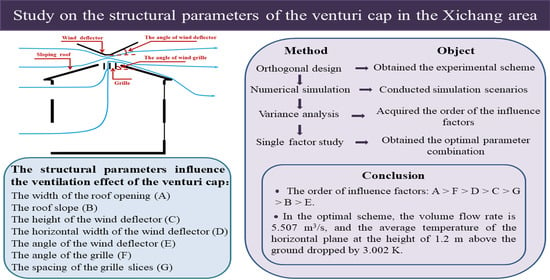Study on the Influence and Optimization of the Venturi Effect on the Natural Ventilation of Buildings in the Xichang Area
Abstract
:1. Introduction
1.1. The Necessity of Natural Ventilation
1.2. Venturi Cap
1.3. Research into Application of the Venturi Effect
1.4. Summary
2. Methodology
2.1. Physical Model
2.2. Numerical Scheme
2.3. Numerical Simulation
2.3.1. Physical Properties of Building Materials and Boundary Conditions
2.3.2. Grid Division
2.3.3. Computational Fluid Dynamics (CFD) Theory
3. Results and Discussion
3.1. Analysis of Variance
3.2. Single Factor Study
4. Conclusions and Outlook
4.1. Conclusions
- Variance analysis showed that the width of the roof opening had a highly significant effect on the ventilation performance of the venturi cap, while the angle of the grille and the horizontal width of the wind deflector had a significant impact. The height of the wind deflector, the spacing of the grille slices, roof slope, and the angle of the wind deflector were not significant.
- On the basis of the analysis of the highly significant factors and the significant factors, it was found that the best solution was N34, that is, the width of the roof opening, the angle of the grille, the horizontal width of wind deflector, the height of wind deflector, the spacing of the grille slices, the roof slope and the angle of wind deflector were assigned values of 1000 mm (A4), 15° (B1), 800 mm (C4), 400 mm (D2), 45° (E4), 75° (F3), and 40 mm (G2), respectively; the volume flow rate reached 5.507 m3/s, and the average temperature of the horizontal plane at a height of 1.2 m above the ground dropped by 3.002 K.
4.2. Outlook
Author Contributions
Funding
Institutional Review Board Statement
Informed Consent Statement
Data Availability Statement
Acknowledgments
Conflicts of Interest
References
- Bojić, M.; Johannes, K.; Kuznik, F. Optimizing energy and environmental performance of passive Trombe wall. Energy Build. 2014, 70, 279–286. [Google Scholar] [CrossRef]
- Kwan, Y.; Guan, L. Design a Zero Energy House in Brisbane, Australia. Procedia Eng. 2015, 121, 604–611. [Google Scholar] [CrossRef] [Green Version]
- Guo, J.; Guan, N.; Liu, H. Numerical Simulation of Natural Ventilation in a Zero-Energy Building—Optimal design of zero-energy solar housing prototype based on numerical simulation. Build. Energy Conserv. 2014, 42, 13–17. [Google Scholar]
- Teng, J.; Li, M.; Wang, W.; Mu, X. A Study on Energy-saving Rate of Ventilation and Shading Technical Plans of Residential Buildings in Severely Cold Areas. J. Eng. Manag. 2020, 34, 69–73. [Google Scholar]
- Yang, Y.K.; Kim, M.Y.; Song, Y.W.; Choi, S.H.; Park, J.C. Windcatcher Louvers to Improve Ventilation Efficiency. Energies 2020, 13, 4459. [Google Scholar] [CrossRef]
- Park, B.; Lee, S. Investigation of the Energy Saving Efficiency of a Natural Ventilation Strategy in a Multistory School Building. Energies 2020, 13, 1746. [Google Scholar] [CrossRef] [Green Version]
- Fang, S. Natural Ventilation Optimization Design Research of Students’ Dormitory in Wuhan Universities in Summer. Master’s Thesis, Huazhong University of Science and Technology, Wuhan, China, 2012. [Google Scholar]
- Xu, T. Indoor Air Quality Control of University Dormitory Based on Fluent Software. Master’s Thesis, Shenyang Architectural University, Shenyang, China, 2018. [Google Scholar]
- Li, Y.; Xi, J.; Wang, J.; Liang, B. Review of Research on Wind Energy Utilization Technology. SD. Chem. Ind. 2019, 48, 124–125. [Google Scholar]
- Gao, Y.; Ma, S.; Wang, T.; Wang, T.; Gong, Y.; Peng, F.; Tsunekawa, A. Assessing the wind energy potential of China in considering its variability/intermittency. Energy Convers. Manag. 2020, 226, 113580. [Google Scholar] [CrossRef]
- Xiao, L. Xichang Contemporary Architecture Creation Characteristics—In Public Buildings and Residential Buildings. Master’s Thesis, Southwest Jiaotong University, Chengdu, China, 2013. [Google Scholar]
- Ji, D.; Zhang, M.; Xu, T.; Wang, K.; Li, P.; Ju, F. Experimental and numerical studies of the jet tube based on venturi effect. Vacuum 2015, 111, 25–31. [Google Scholar] [CrossRef]
- Li, M.; Bussonnière, A.; Bronson, M.; Xu, Z.; Liu, Q. Study of Venturi tube geometry on the hydrodynamic cavitation for the generation of microbubbles. Miner. Eng. 2019, 132, 268–274. [Google Scholar] [CrossRef]
- Shi, H.; Li, M.; Nikrityuk, P.; Liu, Q. Experimental and numerical study of cavitation flows in venturi tubes: From CFD to an empirical model. Chem. Eng. Sci. 2019, 207, 672–687. [Google Scholar] [CrossRef]
- Bimestre, T.; Júnior, J.A.M.; Botura, C.A.; Canettieri, E.V.; Tuna, C. Theoretical modeling and experimental validation of hydrodynamic cavitation reactor with a Venturi tube for sugarcane bagasse pretreatment. Bioresour. Technol. 2020, 311, 123540. [Google Scholar] [CrossRef]
- Zhu, J.; Xie, H.; Feng, K.; Zhang, X.; Si, M. Unsteady cavitation characteristics of liquid nitrogen flows through venturi tube. Int. J. Heat Mass Transf. 2017, 112, 544–552. [Google Scholar] [CrossRef]
- Long, X.; Zhang, J.; Wang, J.; Xu, M.; Lyu, Q.; Ji, B. Experimental investigation of the global cavitation dynamic behavior in a venturi tube with special emphasis on the cavity length variation. Int. J. Multiph. Flow 2017, 89, 290–298. [Google Scholar] [CrossRef]
- Pérez, O.G.; Muñoz-Morales, M.; Souza, F.; Sáez, C.; Cañizares, P.; Rodrigo, M. Jet electro-absorbers for the treatment of gaseous perchloroethylene wastes. Chem. Eng. J. 2020, 395, 125096. [Google Scholar] [CrossRef]
- Pérez, J.F.; Llanos, J.; Sáez, C.; López, C.; Cañizares, P.; Rodrigo, M.A. Electrochemical jet-cell for the in-situ generation of hydrogen peroxide. Electrochem. Commun. 2016, 71, 65–68. [Google Scholar] [CrossRef]
- Pérez, J.F.; Llanos, J.; Sáez, C.; López, C.; Cañizares, P.; Rodrigo, M.A. The jet aerator as oxygen supplier for the electrochemical generation of H2O2. Electrochim. Acta 2017, 246, 466–474. [Google Scholar] [CrossRef]
- Pérez, J.F.; Llanos, J.; Sáez, C.; López, C.; Cañizares, P.; Rodrigo, M.A. The pressurized jet aerator: A new aeration system for high-performance H2O2 electrolyzers. Electrochem. Commun. 2018, 89, 19–22. [Google Scholar] [CrossRef]
- Xu, J.; Liu, X.; Pang, M. Numerical and experimental studies on transport properties of powder ejector based on double venturi effect. Vacuum 2016, 134, 92–98. [Google Scholar] [CrossRef]
- Yu, H.; Goldsworthy, L.; Brandner, P.; Li, J.; Garaniya, V. Modelling thermal effects in cavitating high-pressure diesel sprays using an improved compressible multiphase approach. Fuel 2018, 222, 125–145. [Google Scholar] [CrossRef]
- Lei, X.; Liao, Y.; Liao, Q. Simulation of seed motion in seed feeding device with DEM-CFD coupling approach for rapeseed and wheat. Comput. Electron. Agric. 2016, 131, 29–39. [Google Scholar] [CrossRef]
- Quiroz-Pérez, E.; Vázquez-Román, R.; Lesso-Arroyo, R.; Barragán-Hernández, V.M. An approach to evaluate Venturi-device effects on gas wells production. J. Pet. Sci. Eng. 2014, 116, 8–18. [Google Scholar] [CrossRef]
- Pan, Y.; Lin, R.; Liu, B. Optimal Design of the Smoke Extraction Fan Outlet Based on Venturi Effect. Ind. Safety Environ. Prot. 2018, 44, 27–31. [Google Scholar]
- Li, X. Research on a Natural Smoke Exhaust Device Using Venturi Effect to Improve Exhaust Performance under External Wind. Master’s Thesis, Chongqing University, Chongqing, China, 2019. [Google Scholar]
- De Oliveira, M.A.; De Moraes, P.G.; De Andrade, C.L.; Bimbato, A.M.; Pereira, L.A.A. Control and Suppression of Vortex Shedding from a Slightly Rough Circular Cylinder by a Discrete Vortex Method. Energies 2020, 13, 4481. [Google Scholar] [CrossRef]
- Shishodia, B.S.; Sanghi, S.; Mahajan, P. Computational and subjective assessment of ventilated helmet with venturi effect and backvent. Int. J. Ind. Ergon. 2018, 68, 186–198. [Google Scholar] [CrossRef]
- Reiter, S. Assessing Wind Comfort in Urban Planning. Environ. Plan. B Plan. Des. 2010, 37, 857–873. [Google Scholar] [CrossRef] [Green Version]
- Juan, Y.-H.; Wen, C.-Y.; Chen, W.-Y.; Yang, A.-S. Numerical assessments of wind power potential and installation arrangements in realistic highly urbanized areas. Renew. Sustain. Energy Rev. 2021, 135, 110165. [Google Scholar] [CrossRef]
- Blocken, B.; Stathopoulos, T.; Carmeliet, J. Wind Environmental Conditions in Passages between Two Long Narrow Perpendicular Buildings. J. Aerosp. Eng. 2008, 21, 280–287. [Google Scholar] [CrossRef] [Green Version]
- Li, B.; Luo, Z.; Sandberg, M.; Liu, J. Revisiting the ‘Venturi effect’ in passage ventilation between two non-parallel buildings. Build. Environ. 2015, 94, 714–722. [Google Scholar] [CrossRef]
- Allegrini, J.; Lopez, B. The influence of angular configuration of two buildings on the local wind climate. J. Wind. Eng. Ind. Aerodyn. 2016, 156, 50–61. [Google Scholar] [CrossRef]
- Chong, W.T.; Wang, X.H.; Wong, K.H.; Mojumder, J.C.; Poh, S.C.; Saw, B.; Lai, S.H. Performance assessment of a hybrid solar-wind-rain eco-roof system for buildings. Energy Build. 2016, 127, 1028–1042. [Google Scholar] [CrossRef]
- Wang, X.H.; Chong, W.T.; Wong, K.H.; Saw, L.H.; Lai, S.H.; Wang, C.-T.; Poh, S.C. The Design, Simulation and Testing of V-shape Roof Guide Vane Integrated with an Eco-roof System. Energy Procedia 2017, 105, 750–763. [Google Scholar] [CrossRef]
- Ameer, S.A.; Chaudhry, H.N.; Agha, A. Influence of roof topology on the air distribution and ventilation effectiveness of wind towers. Energy Build. 2016, 130, 733–746. [Google Scholar] [CrossRef]
- Blocken, B.; van Hooff, T.; Aanen, L.; Bronsema, B. Computational analysis of the performance of a venturi-shaped roof for natural ventilation: Venturi-effect versus wind-blocking effect. Comput. Fluids 2011, 48, 202–213. [Google Scholar] [CrossRef]
- Van Hooff, T.; Blocken, B.; Aanen, L.; Bronsema, B. A venturi-shaped roof for wind-induced natural ventilation of buildings: Wind tunnel and CFD evaluation of different design configurations. Build. Environ. 2011, 46, 1797–1807. [Google Scholar] [CrossRef] [Green Version]
- Van Hooff, T.; Blocken, B.; Aanen, L.; Bronsema, B. Numerical analysis of the performance of a venturi-shaped roof for natural ventilation: Influence of building width. J. Wind. Eng. Ind. Aerodyn. 2012, 104, 419–427. [Google Scholar] [CrossRef]
- Kumar, N.; Kubota, T.; Tominaga, Y.; Shirzadi, M.; Bardhan, R. CFD simulations of wind-induced ventilation in apartment buildings with vertical voids: Effects of pilotis and wind fin on ventilation performance. Build. Environ. 2021, 194, 107666. [Google Scholar] [CrossRef]
- Li, Z.; Zhang, H.; Wen, C.-Y.; Yang, A.-S.; Juan, Y.-H. The effects of lateral entrainment on pollutant dispersion inside a street canyon and the corresponding optimal urban design strategies. Build. Environ. 2021, 195, 107740. [Google Scholar] [CrossRef]
- Prianto, E.; Depecker, P. Characteristics of airflow as the effect of balcony, opening design and internal division on indoor velocity: A case study of traditional dwelling in urban living quarter in tropical humid region. Energy Build. 2002, 34, 401–409. [Google Scholar] [CrossRef]
- Prianto, E.; Depecker, P. Optimization of architectural design elements in tropical humid region with thermal comfort approach. Energy Build. 2003, 35, 273–280. [Google Scholar] [CrossRef]
- Raja, I.A.; Nicol, J.F.; McCartney, K.J.; Humphreys, M.A. Thermal comfort: Use of controls in naturally ventilated buildings. Energy Build. 2001, 33, 235–244. [Google Scholar] [CrossRef]
- Stavrakakis, G.; Zervas, P.; Sarimveis, H.; Markatos, N. Optimization of window-openings design for thermal comfort in naturally ventilated buildings. Appl. Math. Model. 2012, 36, 193–211. [Google Scholar] [CrossRef]
- Muhsin, F.; Yusoff, W.F.M.; Mohamed, M.F.; Sapian, A.R. CFD modeling of natural ventilation in a void connected to the living units of multi-storey housing for thermal comfort. Energy Build. 2017, 144, 1–16. [Google Scholar] [CrossRef]
- Wang, B.; Cot, L.; Adolphe, L.; Geoffroy, S.; Morchain, J. Estimation of wind energy over roof of two perpendicular buildings. Energy Build. 2015, 88, 57–67. [Google Scholar] [CrossRef]
- Hughes, B.R.; Calautit, J.K.; Ghani, S. The development of commercial wind towers for natural ventilation: A review. Appl. Energy 2012, 92, 606–627. [Google Scholar] [CrossRef]
- De Paepe, M.; Pieters, J.; Cornelis, W.M.; Gabriels, D.; Merci, B.; Demeyer, P. Airflow measurements in and around scale model cattle barns in a wind tunnel: Effect of ventilation opening height. Biosyst. Eng. 2012, 113, 22–32. [Google Scholar] [CrossRef]
- Fan, J. Liangshan Yi Architectural Context and Its Expression in the Inheritance and Development of Modern City. Master’s Thesis, Chongqing University, Chongqing, China, 2012. [Google Scholar]
- Hou, B. The Civil Residence Architecture of Liangshan Yi and Its Architecture cultural phenomena. Master’s Thesis, Chongqing University, Chongqing, China, 2004. [Google Scholar]
- Ke, Y. A Brick Houses with Adobe Dwellings in Thermal Comfort Study. Master’s Thesis, Southwest Jiaotong University, Chengdu, China, 2018. [Google Scholar]
- EnergyPlus. Available online: https://energyplus.net/ (accessed on 10 August 2020).
- Zhang, L.; Hou, Y.; Liu, Z.; Du, J.; Xu, L.; Zhang, G.K.; Shi, L. Trombe wall for a residential building in Sichuan-Tibet alpine valley—A case study. Renew. Energy 2020, 156, 31–46. [Google Scholar] [CrossRef]
- Potgieter, M.; Bester, C.; Bhamjee, M. Experimental and CFD investigation of a hybrid solar air heater. Sol. Energy 2020, 195, 413–428. [Google Scholar] [CrossRef]
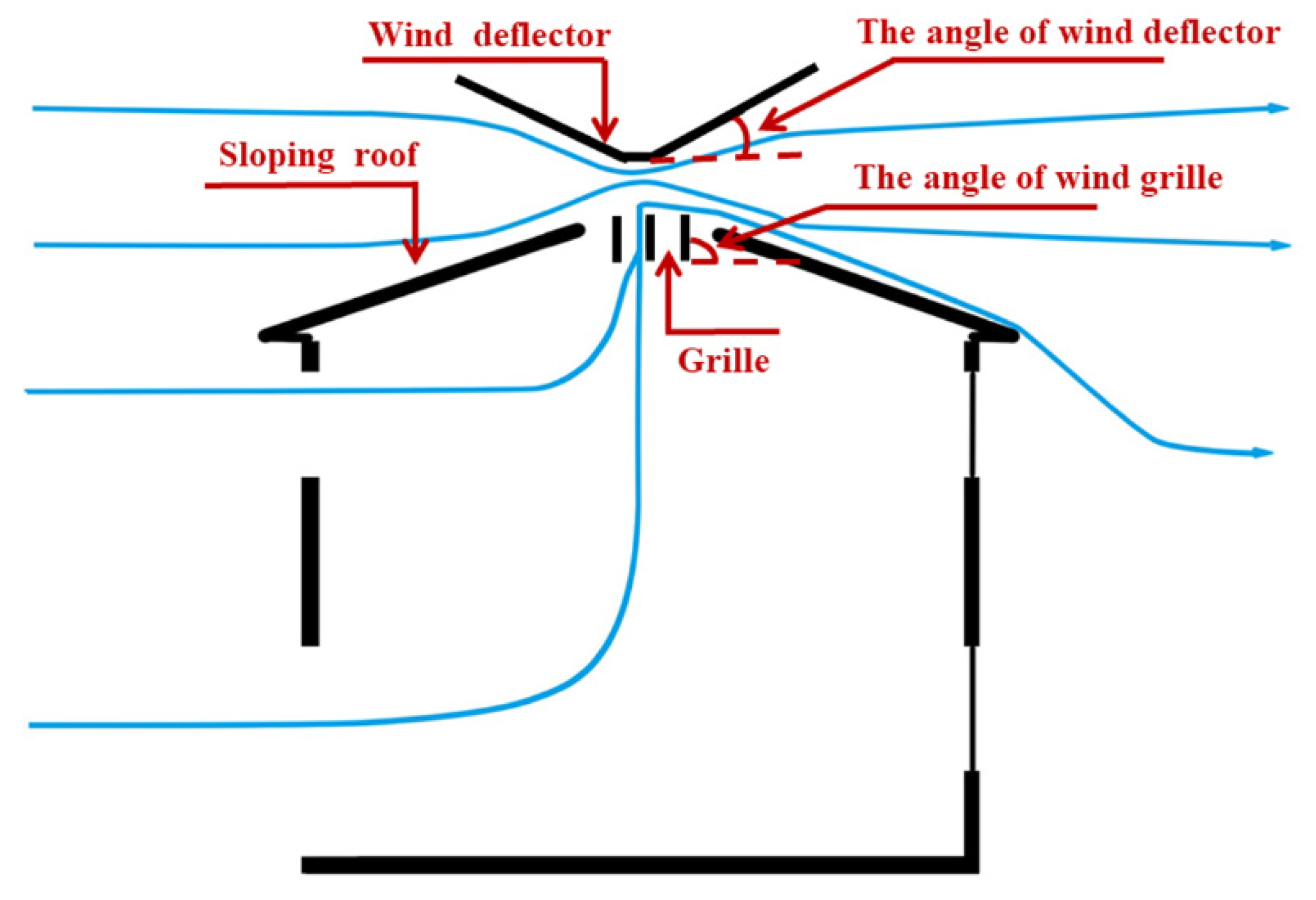
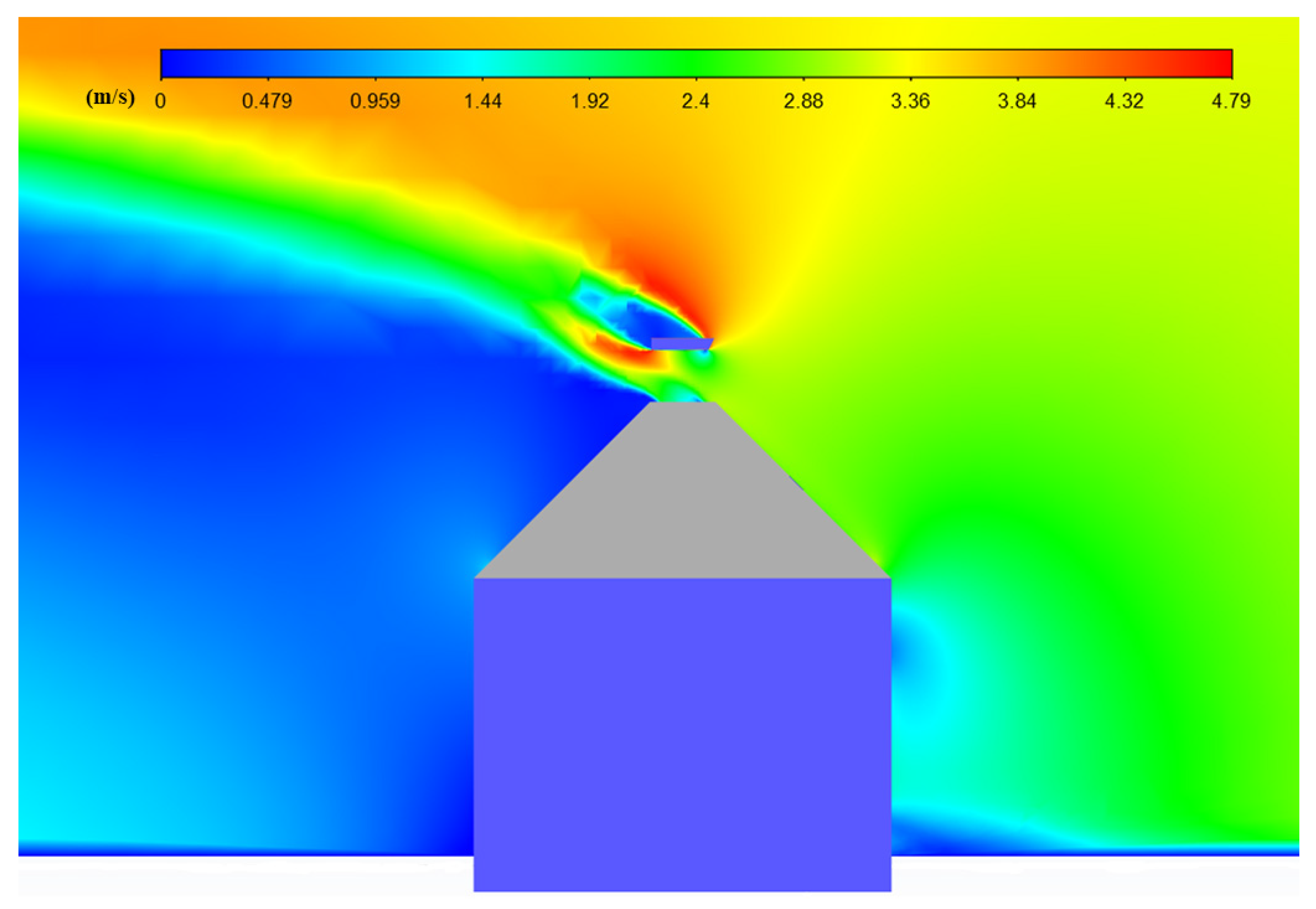
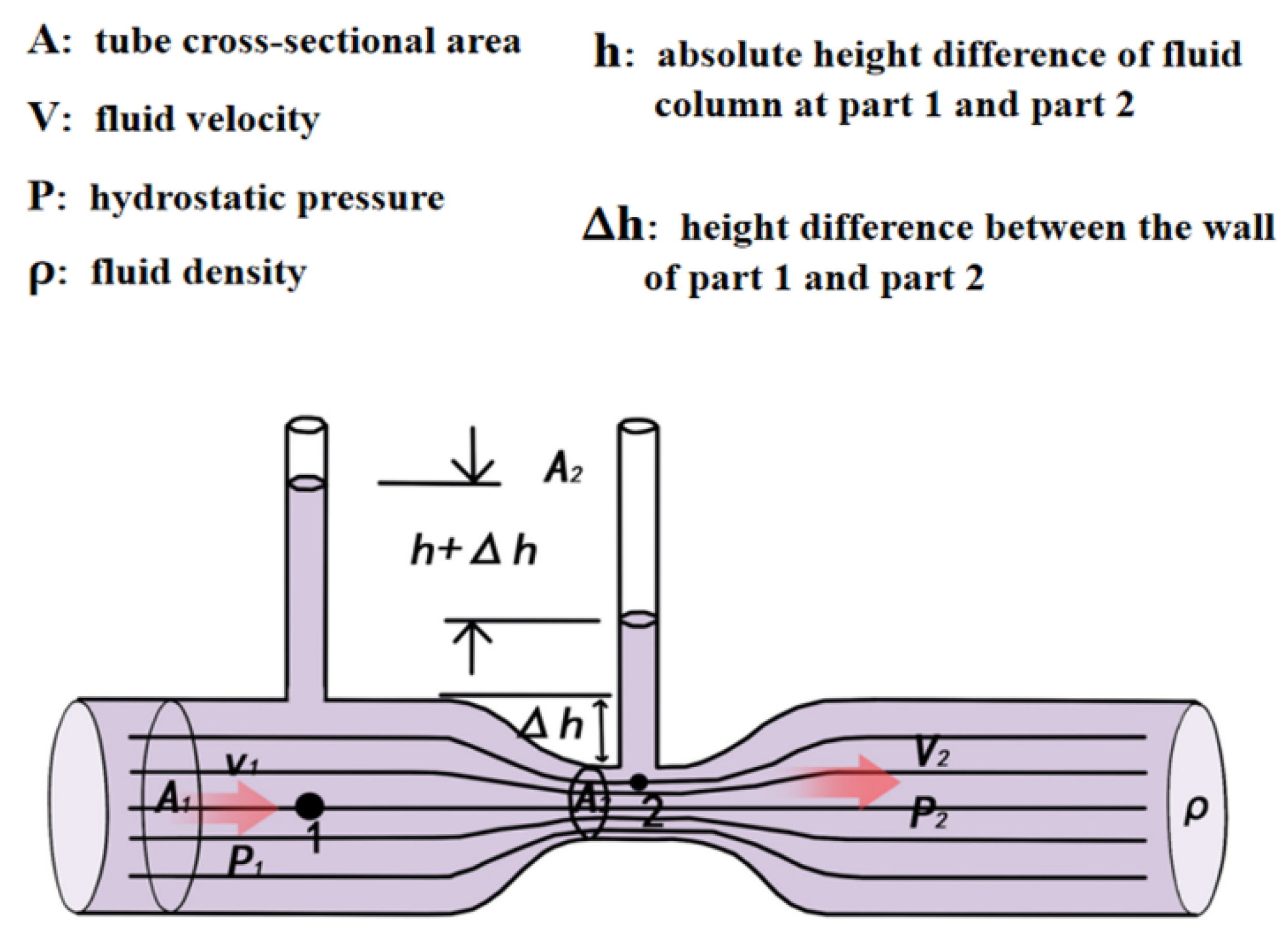
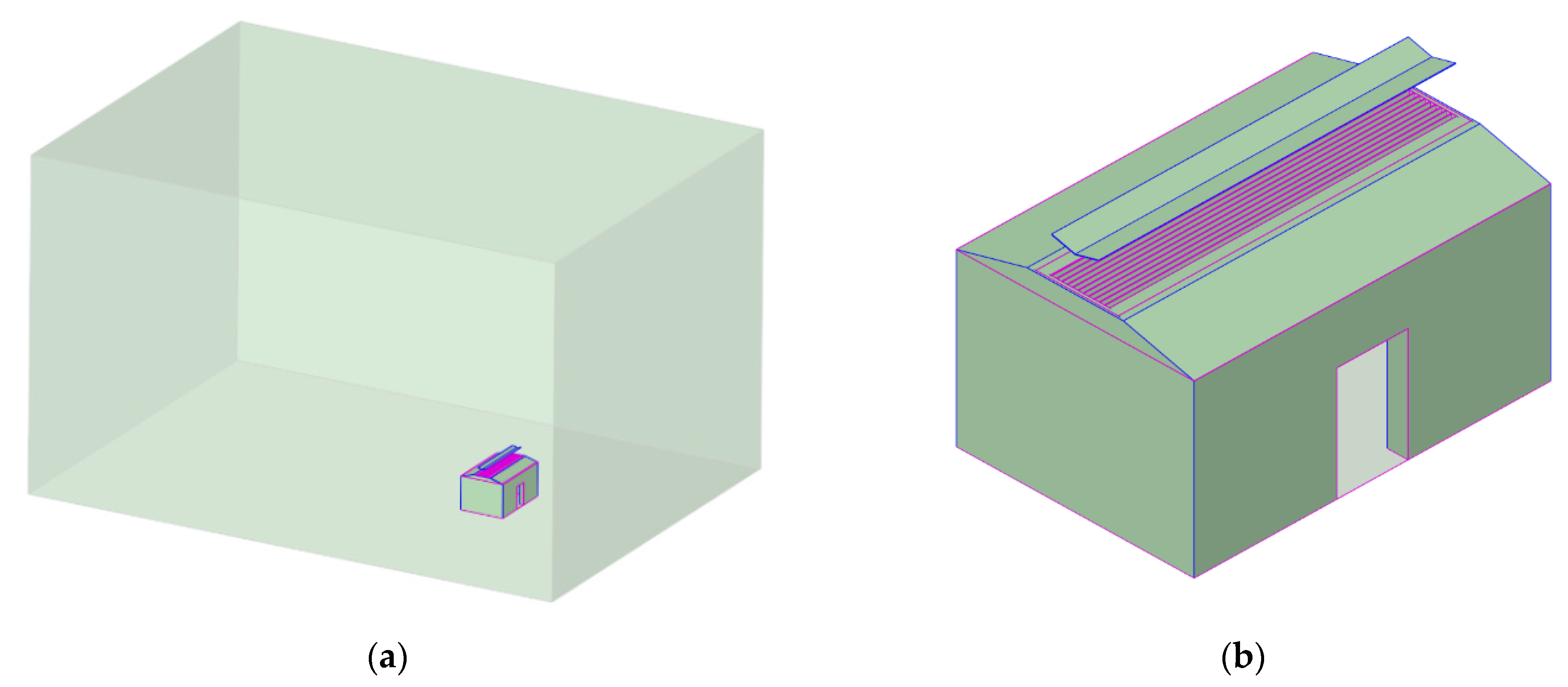
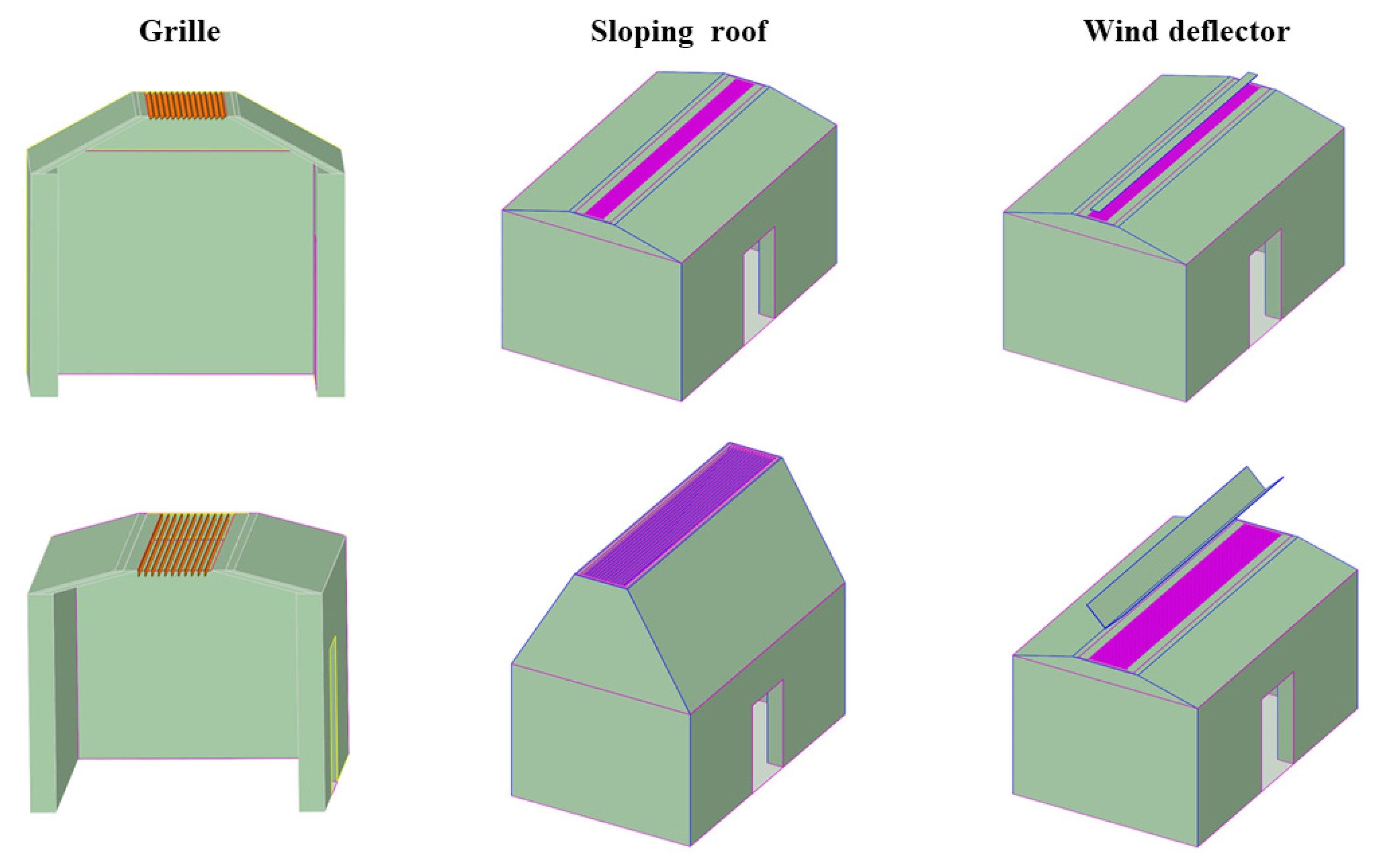
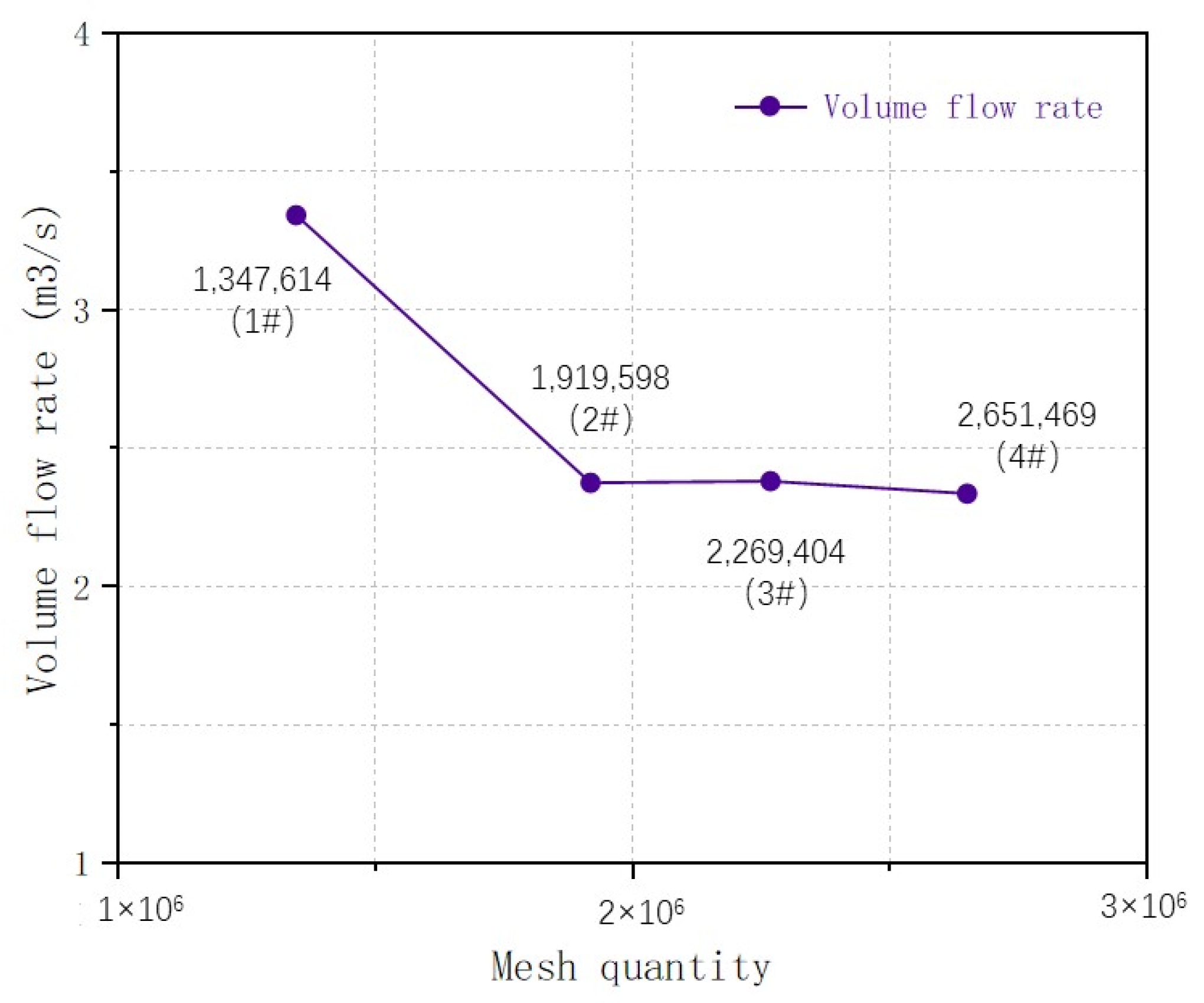
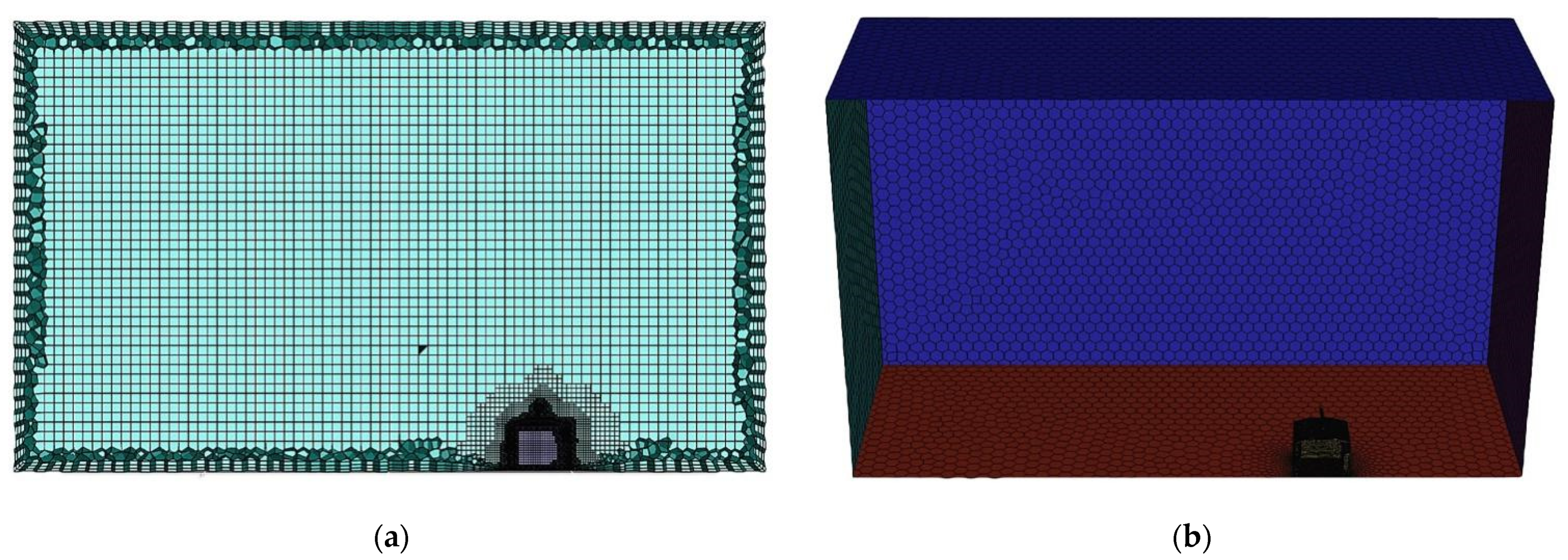
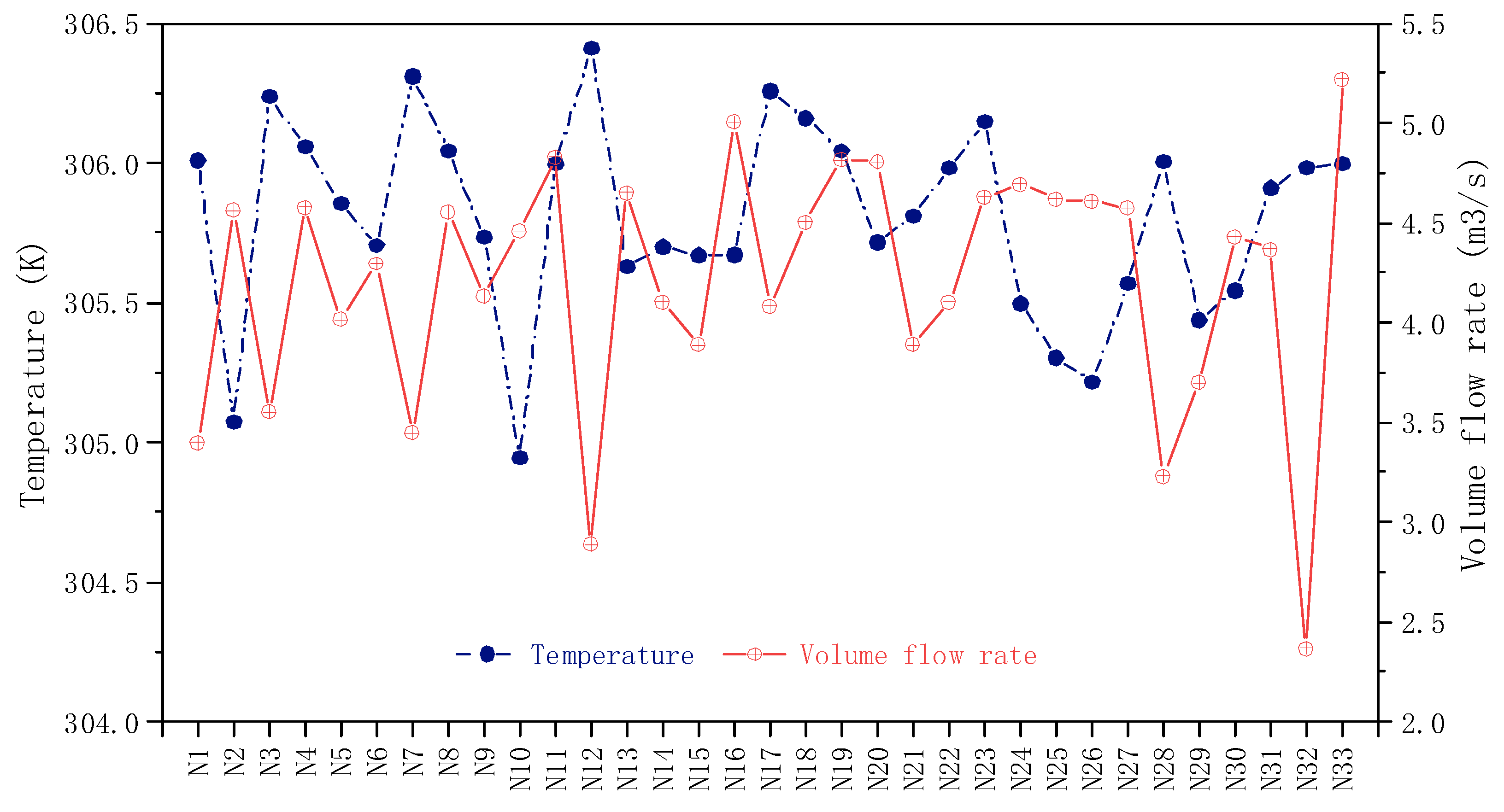

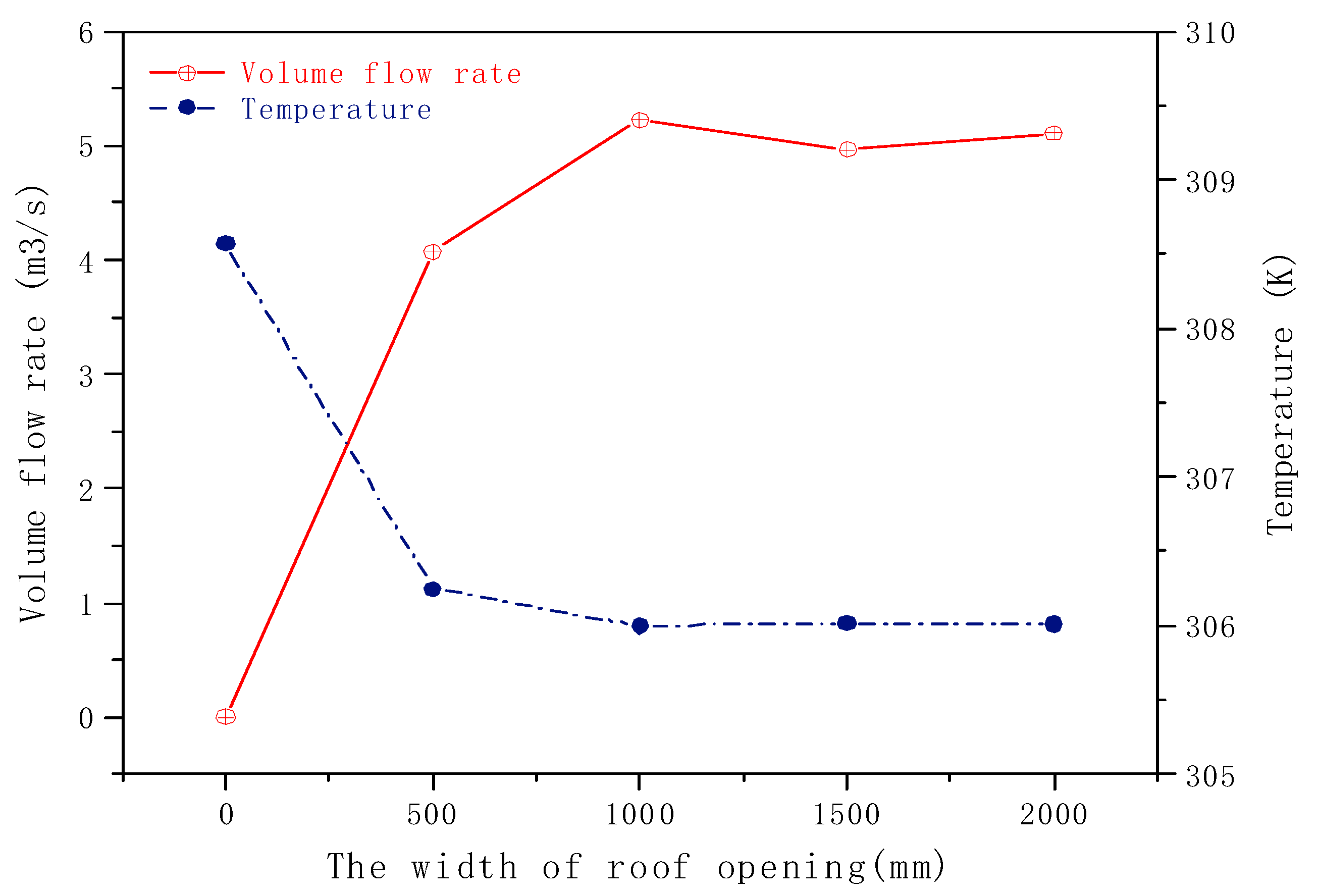

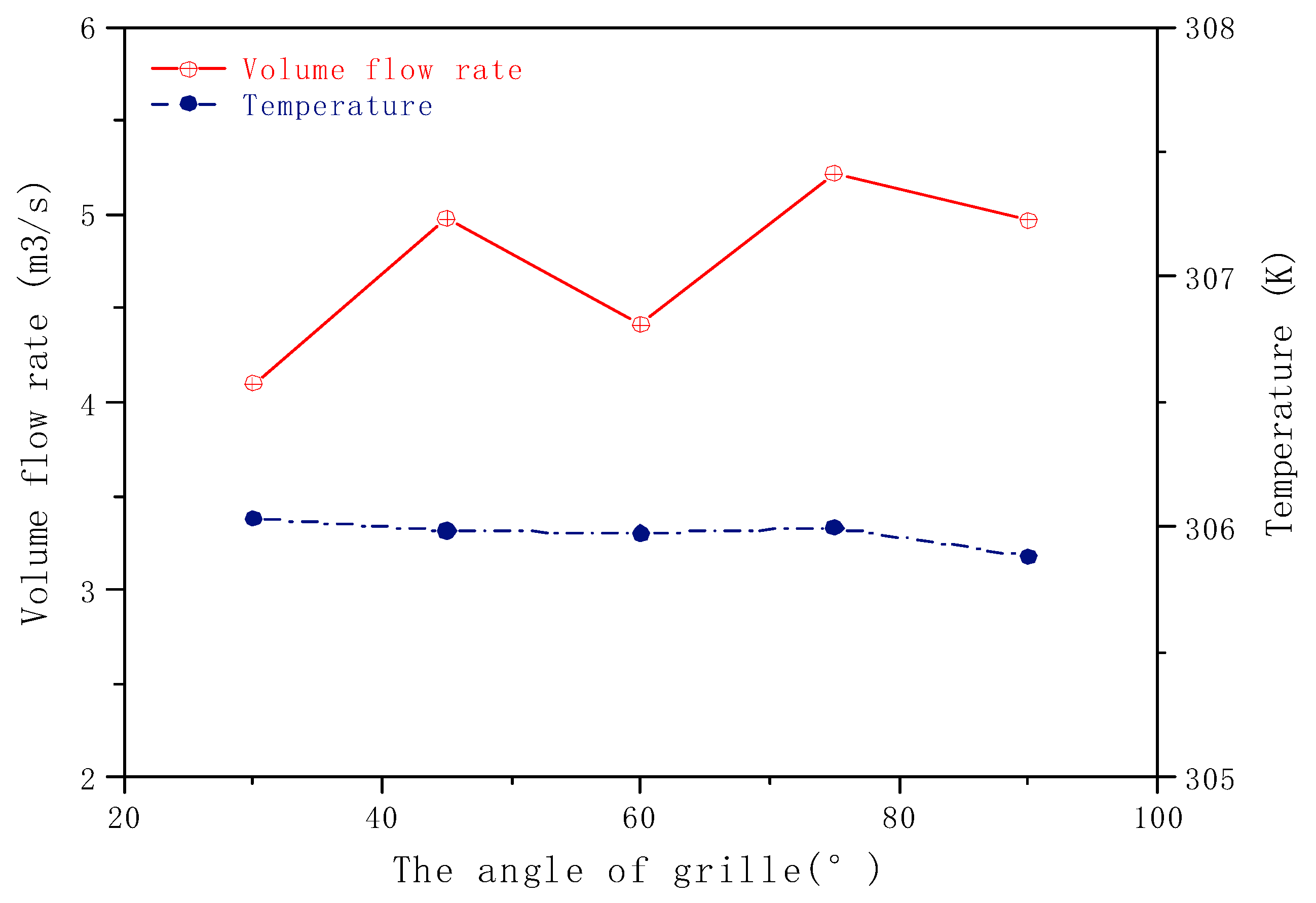
| Scene | Width of Roof Opening (mm) | Roof Slope (°) | Height of Wind Deflector (mm) | Horizontal Width of Wind Deflector (mm) | Angle of Wind Deflector (°) | Angle of Grille (°) | Spacing of Grille Slices (mm) | Building Height (mm) | Volume Flow Rate (m3/s) |
|---|---|---|---|---|---|---|---|---|---|
| N1 | 400(A1) | 45(B3) | 600(C3) | 600(D3) | 0(E1) | 75(F3) | 20(G1) | 3843.430 | 3.399 |
| N2 | 800(A3) | 30(B2) | 600(C3) | 200(D1) | 0(E1) | 60(F2) | 80(G4) | 3415.690 | 4.563 |
| N3 | 600(A2) | 60(B4) | 600(C3) | 400(D2) | 15(E2) | 45(F1) | 20(G1) | 4392.245 | 3.553 |
| N4 | 600(A2) | 15(B1) | 400(C2) | 400(D2) | 0(E1) | 60(F2) | 40(G2) | 3372.690 | 4.576 |
| N5 | 600(A2) | 45(B3) | 800(C4) | 600(D3) | 30(E3) | 45(F1) | 80(G4) | 3793.430 | 4.015 |
| N6 | 800(A3) | 15(B1) | 800(C4) | 800(D4) | 45(E4) | 60(F2) | 20(G1) | 3345.900 | 4.297 |
| N7 | 800(A3) | 60(B4) | 200(C1) | 800(D4) | 30(E3) | 45(F1) | 40(G2) | 4305.640 | 3.447 |
| N8 | 1000(A4) | 15(B1) | 600(C3) | 800(D4) | 15(E2) | 90(F4) | 80(G4) | 3319.100 | 4.553 |
| N9 | 600(A2) | 45(B3) | 800(C4) | 800(D4) | 0(E1) | 90(F4) | 40(G2) | 3793.430 | 4.133 |
| N10 | 1000(A4) | 45(B3) | 200(C1) | 400(D2) | 15(E2) | 60(F2) | 80(G4) | 3693.430 | 4.458 |
| N11 | 1000(A4) | 60(B4) | 400(C2) | 600(D3) | 30(E3) | 60(F2) | 20(G1) | 4219.040 | 4.829 |
| N12 | 400(A1) | 15(B1) | 200(C1) | 200(D1) | 0(E1) | 45(F1) | 20(G1) | 3399.490 | 2.890 |
| N13 | 1000(A4) | 30(B2) | 800(C4) | 400(D2) | 0(E1) | 45(F1) | 60(G3) | 3386.825 | 4.651 |
| N14 | 800(A3) | 60(B4) | 200(C1) | 600(D3) | 0(E1) | 90(F4) | 80(G4) | 4305.640 | 4.105 |
| N15 | 400(A1) | 15(B1) | 200(C1) | 400(D2) | 30(E3) | 90(F4) | 60(G3) | 3399.490 | 3.887 |
| N16 | 1000(A4) | 45(B3) | 200(C1) | 200(D1) | 45(E4) | 75(F3) | 40(G2) | 3693.430 | 5.002 |
| N17 | 400(A1) | 60(B4) | 800(C4) | 200(D1) | 15(E2) | 60(F2) | 40(G2) | 4478.845 | 4.083 |
| N18 | 400(A1) | 60(B4) | 800(C4) | 400(D2) | 45(E4) | 75(F3) | 80(G4) | 4478.845 | 4.502 |
| N19 | 600(A2) | 60(B4) | 600(C3) | 200(D1) | 45(E4) | 90(F4) | 60(G3) | 4392.245 | 4.816 |
| N20 | 1000(A4) | 15(B1) | 600(C3) | 600(D3) | 45(E4) | 45(F1) | 40(G2) | 3319.100 | 4.804 |
| N21 | 400(A1) | 30(B2) | 400(C2) | 600(D3) | 15(E2) | 90(F4) | 40(G2) | 3473.425 | 3.888 |
| N22 | 600(A2) | 30(B2) | 200(C1) | 800(D4) | 15(E2) | 75(F3) | 20(G1) | 3444.560 | 4.103 |
| N23 | 800(A3) | 45(B3) | 400(C2) | 200(D1) | 15(E2) | 45(F1) | 60(G3) | 3743.430 | 4.628 |
| N24 | 1000(A4) | 30(B2) | 800(C4) | 200(D1) | 30(E3) | 90(F4) | 20(G1) | 3386.825 | 4.695 |
| N25 | 800(A3) | 30(B2) | 600(C3) | 400(D2) | 30(E3) | 75(F3) | 40(G2) | 3415.690 | 4.619 |
| N26 | 600(A2) | 15(B1) | 400(C2) | 200(D1) | 30(E3) | 75(F3) | 80(G4) | 3372.690 | 4.610 |
| N27 | 800(A3) | 15(B1) | 800(C4) | 600(D3) | 15(E2) | 75(F3) | 60(G3) | 3345.900 | 4.573 |
| N28 | 400(A1) | 45(B3) | 600(C3) | 800(D4) | 30(E3) | 60(F2) | 60(G3) | 3843.430 | 3.233 |
| N29 | 600(A2) | 30(B2) | 200(C1) | 600(D3) | 45(E4) | 60(F2) | 60(G3) | 3444.560 | 3.701 |
| N30 | 1000(A4) | 60(B4) | 400(C2) | 800(D4) | 0(E1) | 75(F3) | 60(G3) | 4219.040 | 4.431 |
| N31 | 800(A3) | 45(B3) | 400(C2) | 400(D2) | 45(E4) | 90(F4) | 20(G1) | 3743.430 | 4.369 |
| N32 | 400(A1) | 30(B2) | 400(C2) | 800(D4) | 45(E4) | 45(F1) | 80(G4) | 3473.425 | 2.370 |
| Material Properties | Density (kg/m3) | Conductivity (W/(m × k)) | Specific Heat (J/(kg × k)) |
|---|---|---|---|
| Adobe | 1800 | 0.93 | 1010 |
| Wood | 500 | 0.14 | 2510 |
| Al | 2719 | 202.4 | 871 |
| Concrete | 2300 | 1.51 | 920 |
| Factor | p | Significance |
|---|---|---|
| Width of roof opening | 0.001 | Highly significant |
| Roof slope | 0.737 | Not significant |
| Height of wind deflector | 0.224 | Not significant |
| Horizontal width of wind deflector | 0.043 | Significant |
| Angle of wind deflector | 0.86 | Not significant |
| Angle of grille | 0.037 | Significant |
| Spacing of the grille slices | 0.444 | Not significant |
Publisher’s Note: MDPI stays neutral with regard to jurisdictional claims in published maps and institutional affiliations. |
© 2021 by the authors. Licensee MDPI, Basel, Switzerland. This article is an open access article distributed under the terms and conditions of the Creative Commons Attribution (CC BY) license (https://creativecommons.org/licenses/by/4.0/).
Share and Cite
Zhang, L.; Tian, L.; Shen, Q.; Liu, F.; Li, H.; Dong, Z.; Cheng, J.; Liu, H.; Wan, J. Study on the Influence and Optimization of the Venturi Effect on the Natural Ventilation of Buildings in the Xichang Area. Energies 2021, 14, 5053. https://doi.org/10.3390/en14165053
Zhang L, Tian L, Shen Q, Liu F, Li H, Dong Z, Cheng J, Liu H, Wan J. Study on the Influence and Optimization of the Venturi Effect on the Natural Ventilation of Buildings in the Xichang Area. Energies. 2021; 14(16):5053. https://doi.org/10.3390/en14165053
Chicago/Turabian StyleZhang, Lili, Lei Tian, Qiong Shen, Fei Liu, Haolin Li, Zhuojun Dong, Jingyue Cheng, Haoru Liu, and Jiangjun Wan. 2021. "Study on the Influence and Optimization of the Venturi Effect on the Natural Ventilation of Buildings in the Xichang Area" Energies 14, no. 16: 5053. https://doi.org/10.3390/en14165053
APA StyleZhang, L., Tian, L., Shen, Q., Liu, F., Li, H., Dong, Z., Cheng, J., Liu, H., & Wan, J. (2021). Study on the Influence and Optimization of the Venturi Effect on the Natural Ventilation of Buildings in the Xichang Area. Energies, 14(16), 5053. https://doi.org/10.3390/en14165053





